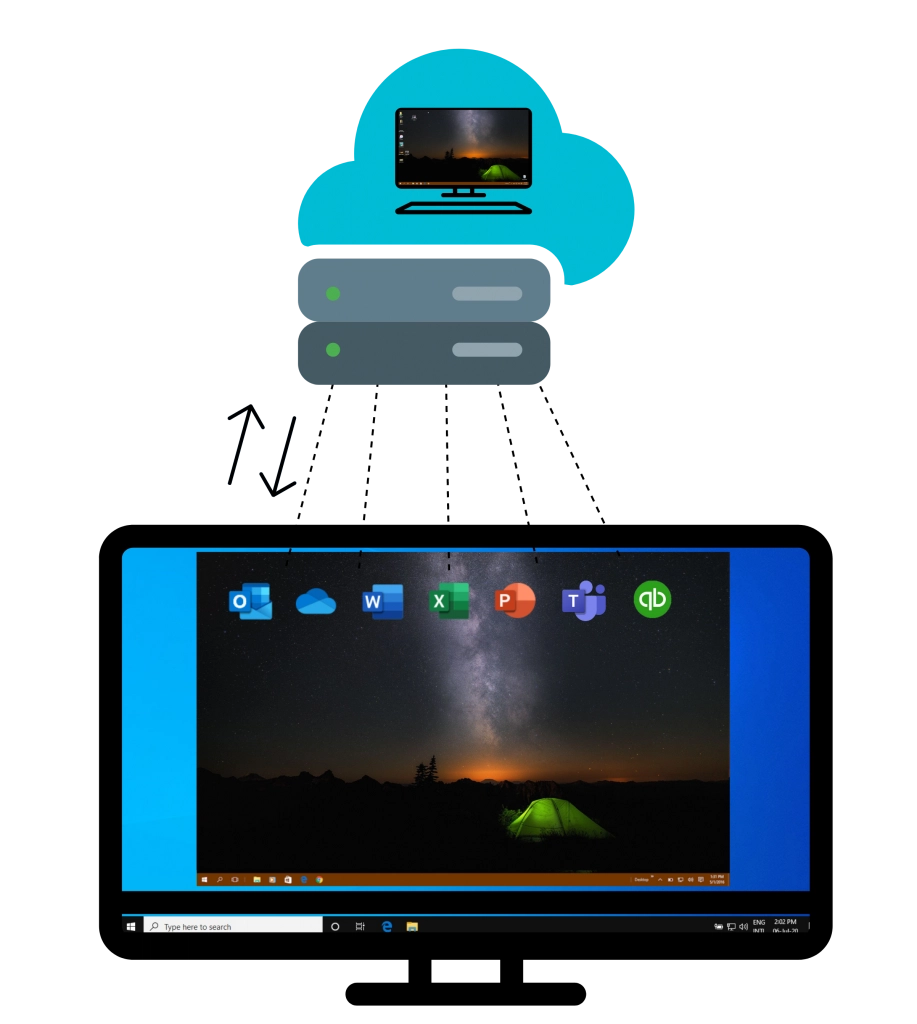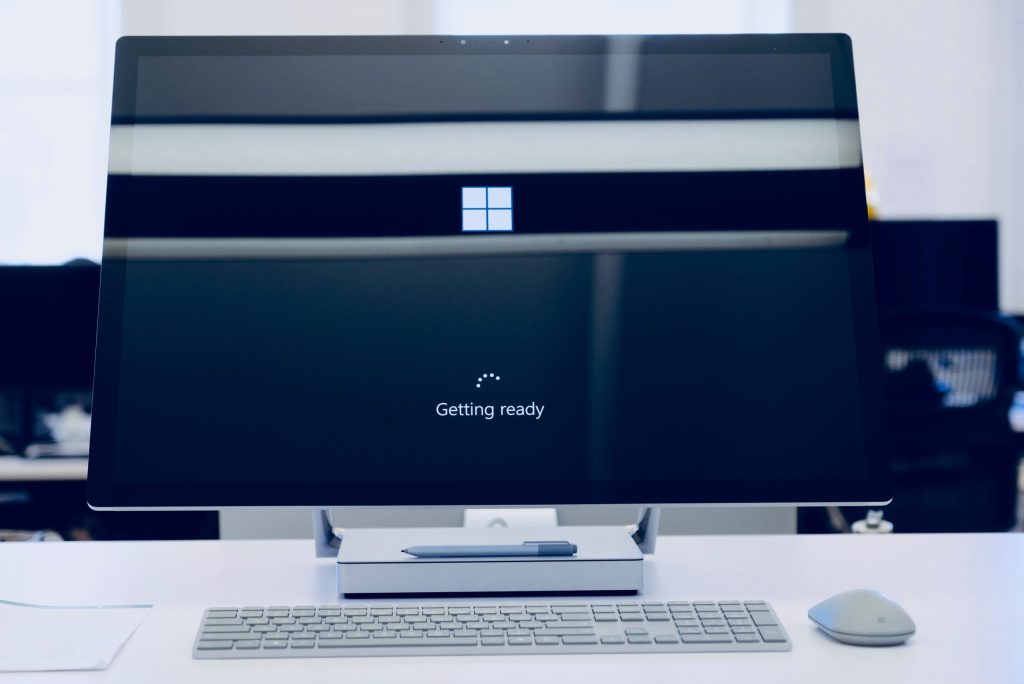Workplaces have changed significantly over the last couple of years in response to COVID-19. As we emerge through the other side, an increasing number of businesses are still utilizing flexible work models, like hybrid work.
Whether you’re exploring a hybrid work arrangement or you’ve already implemented flexible work policies, it’s important to have the right tech in place to support your team, overcome barriers to work, and make sure the arrangement is sustainable in the long term.
Virtual desktops are a relatively new option that have a lot of benefits for businesses, but especially those with hybrid teams. So, let’s take a closer look at how virtual desktops work and how you can use them to support your hybrid employees.
But first, let’s start with some basic definitions.

What is a Hybrid Employee?
A hybrid employee splits their work schedule between the office and home (or other remote location). Some companies have defined schedules for hybrid employees (enabling multiple people to share the same space), while others take a more flexible approach, allowing employees to decide when they come into work.
Hybrid work is becoming increasingly common in 2022 for a number of reasons:
- Supporting greater work-life balance – Working from home means no commute, which frees up time for family, friends, exercise, and hobbies
- Attracting and retaining staff – Hybrid work is a perk that can help reduce turnover and attract new talent, which is more important than ever in 2022 (with annual turnover in the U.S. predicted to jump by 20%)
- Increasing productivity and focus – Some employees work more productively at home and may use this time for tasks that require greater focus
- Building culture, teamwork, and trust – Unlike 100% remote teams, hybrid employees can still participate in face-to-face projects and activities when it counts
- Saving on costs – Fewer people in-house means you don’t need to invest in a bigger space and more desks as you scale up (this is especially beneficial for small businesses with limited resources)
Of course, we’re not here to sell you on hybrid work. If you’re reading this article, you probably already know the benefits. What you really need to know is how you can make it work from a tech perspective. And that brings us to virtual desktops…
What’s a virtual desktop and how does it work?
Virtual desktops (also known as Desktop-as-a-Service or DaaS) work a lot like the cloud storage systems you probably already use, like OneDrive, Dropbox, and iCloud.
With each of these providers, files are stored in the cloud instead of on your computer hard drive or local network systems (where they might be accidentally deleted or destroyed). Files are easy to access via a share link or a shared folder system on any internet-enabled device.
When it comes to virtual desktops, your entire desktop (including files, apps, and the hardware that runs them) is stored in the cloud. This means everything can be accessed on any laptop, smartphone, or home computer that’s connected to the internet. Any changes made while accessing your virtual desktop are immediately stored in the cloud so that your desktop is always up-to-date, even if you sign in on a different device.
Popular products on the market include Microsoft Azure (our personal favorite), Amazon Workspaces, VMWare Horizon Cloud, V2 Cloud, and Citrix DaaS.
An increasing number of businesses (especially small businesses and those with hybrid employees) are choosing virtual desktops over the alternatives. So, what’s behind the rise in virtual desktops?

11 virtual desktop benefits for hybrid work
Virtual desktops can help hybrid employees (and their employers) overcome technology barriers so that they can flow seamlessly from the office environment to remote work. But let’s get specific about some of these barriers and desktop virtualization benefits…
1. Easy adoption
One of the barriers to adopting new tech is getting staff to understand and accept it. Fortunately, most hybrid work employees will already be familiar with cloud-based software and storage systems, making it easy to explain how virtual desktops work — and easy for staff to get onboard.
Azure Virtual Desktop’s interface will feel extremely familiar to existing Windows 10 users, as it has the same functions, apps, files, icons, and settings as a physical computer.

2. Pick up where they left off
47 tabs open? No problem. Staff can drop what they’re doing at any point and know that the applications, files, and browser tabs will be exactly as they left them, even if they open their virtual desktop days later, on a completely different device.
Azure Virtual Desktop’s interface will feel extremely familiar to existing Windows 10 or Windows 11 users, as it has the same functions, apps, files, icons, and settings as a physical computer.
3. Work more productively
Virtual desktops can reduce the amount of time employees take to get into their work and improve productivity and efficiency.
This is backed up by a study that found virtual desktops benefit people by allowing them to resume tasks more quickly — and reduce their cognitive load during sequential multitasking.
4. Streamlined access
One of the first steps in onboarding a new team member (whether hybrid or not) is getting them set up on a computer, with access to files and software. Sometimes new team members will lose days (and momentum) while waiting for IT to source a computer, wipe previous data, perform maintenance, and set it up with all the necessary applications.
A virtual desktop system like Microsoft Azure makes this process fast and easy, with everything done in just a few clicks. Best of all, hybrid employees don’t even need to complete their onboarding in the office, with the option to set up their virtual desktop on a phone, tablet, laptop, or home-based PC.
5. Easily replace hardware
Because virtual desktop installation and configuration is so simple, it’s much easier to set up a replacement device if the hardware fails or needs an upgrade. And decommissioning an old device is just as easy because no company files are stored locally.
6. Simpler security
In order to work efficiently, staff need to be able to easily access the data they need, when they need it. But it’s challenging to manage security if employees are accessing and storing company data across a range of devices. This is especially problematic for hybrid employees that may need to sign into company systems via home or public networks (and may not understand how to make their device secure). It’s also a common issue for small businesses that don’t have the luxury of an in-house IT team to identify and manage security issues.
Fortunately, data security and compliance is much simpler to manage and control with virtual desktop infrastructure, because information and applications aren’t stored locally. You won’t lose any data if your device is lost, hacked, or stolen.
At Protek-IT, we remotely manage clients’ vulnerabilities and assess compliance via Azure Security Center, using features like:
- 2-factor authentication
- Conditional access
- Malware protection
- Antivirus protection
- Audit logs

7. Lower cost devices
Virtual desktops don’t require a local hard drive. This means that instead of buying expensive, fully-resourced traditional PCs (that require more maintenance), companies can invest in lower-cost thin client computers.
For growing small businesses, it’s easier and more affordable to scale up and add more devices as their team grows. Especially with all the data and applications in one centralized location.
8. Bring your own device

With virtual desktops, the device your employees use for work becomes a much less critical component — and one that has very little impact on the user experience. This allows some businesses to establish a bring-your-own-device (BOYD) policy and removes the need for significant hardware investment.
Although Azure Virtual Desktop closely resembles Windows 10, it can work on PCs, laptops, tablets, and smartphones (both Android and iOS), and the interface automatically adjusts to any screen size. This means employees can work on a device they already own — or choose a device they’re most comfortable with.
9. Better energy efficiency
Enabling hybrid employees to regularly work from home reduces energy consumption in the workplace. Plus, fewer commutes also leads to lower carbon emissions (and savings for your employees).
Beyond this, less powerful computers (operating on virtual desktop infrastructure) consume less energy than traditional PCs and workstations. This can reduce the cost to power your business, lower your carbon footprint, and even reduce your organizations’ e-waste.
10. No planning? No problem.

One of the benefits of hybrid work (for many employees) is the flexibility to decide on the day if they’re going to work from home or in the office.
If something comes up and your employees can’t commute to work as planned, they can work from home (or wherever they are) via their virtual desktop. There’s no need to email themselves files, check out a work laptop, make sure their cloud storage is synced, or organize access to software. Without having to plan in advance, they’ll have all their tools and resources at their fingertips.
11. Better work/life balance.
Many hybrid employees use the same device for both work and personal activities, which can make it tricky to:
- Manage work vs personal time
- Focus on work tasks
- Create healthy boundaries
- Find work-life balance (one of the main reasons employees choose to go hybrid)
Virtual desktops help create separation between work and personal life by allowing employees to switch away from their personal environment and enter a dedicated work environment, even if they use one device for both.
This works in reverse, too. When employees aren’t at work, they can switch off from work and enjoy their downtime. Which means they’re more likely to come back refreshed and motivated for work.
Ready to implement virtual desktops?
Protek-IT is an award winning IT support provider, recently awarded a 2022 Channel Futures NextGen 101 Award, recognized as, and listed among the top IT services companies in Chicago.
We’re experts in implementing Microsoft 365 and Azure Cloud, which includes Virtual Desktops, along with a range of other tools (and benefits) that can help support your hybrid work environment.
With Azure Cloud, we’ve helped our clients enjoy the benefits of virtual desktops and hybrid work, like increased reliability and flexibility, and (in many cases) lower costs. Best of all, Azure Cloud is accessible to even the smallest businesses, because you only pay for the resources you use.
Want our help? To get started, reach out to our team to request a custom estimate for your workplace, along with tech suggestions to help support your hybrid employees.
Further reading
Want to learn more? Check out our article on the future of small business IT or explore our Microsoft 365 and Azure Cloud Services for small business and nonprofits.



